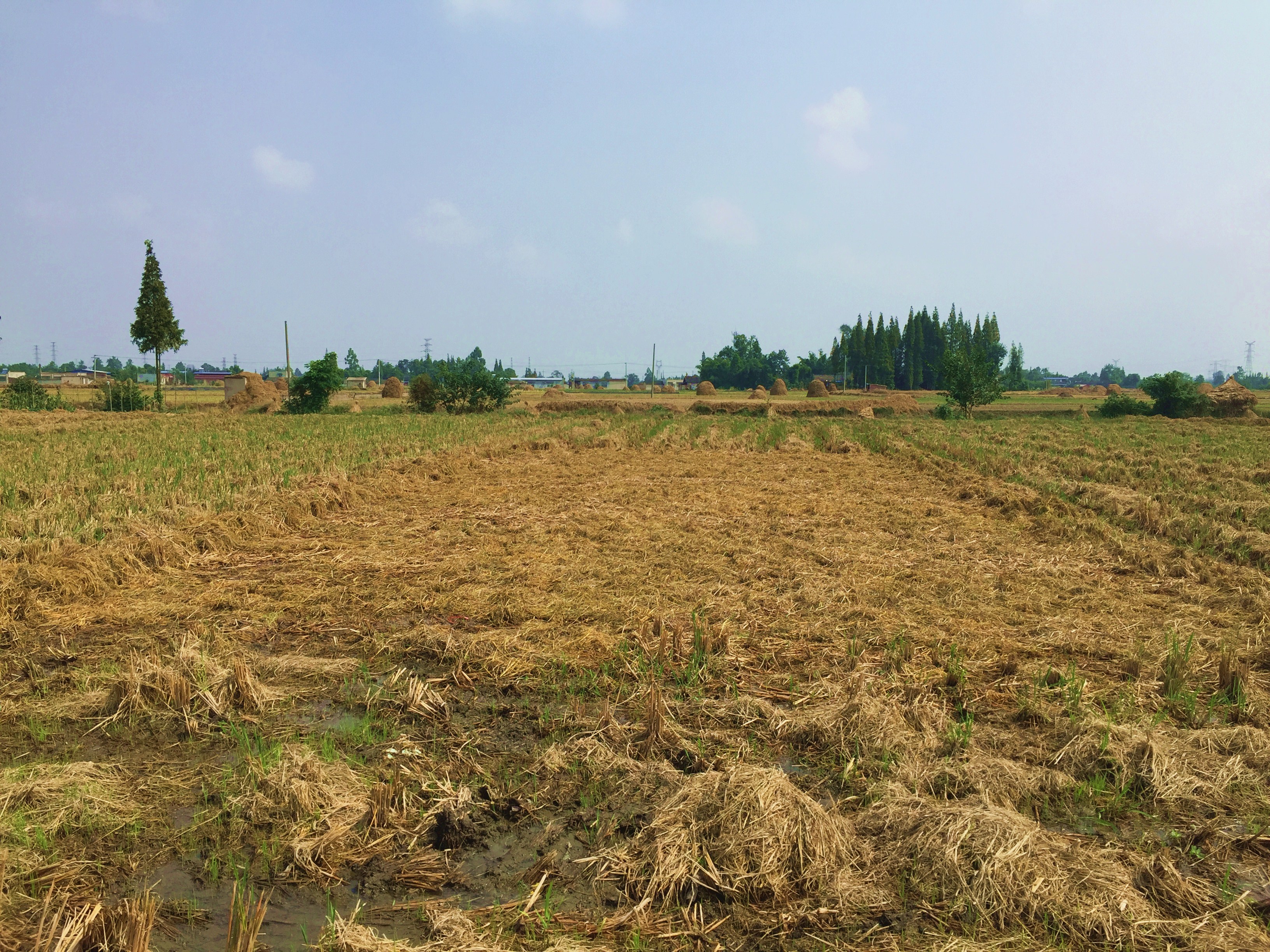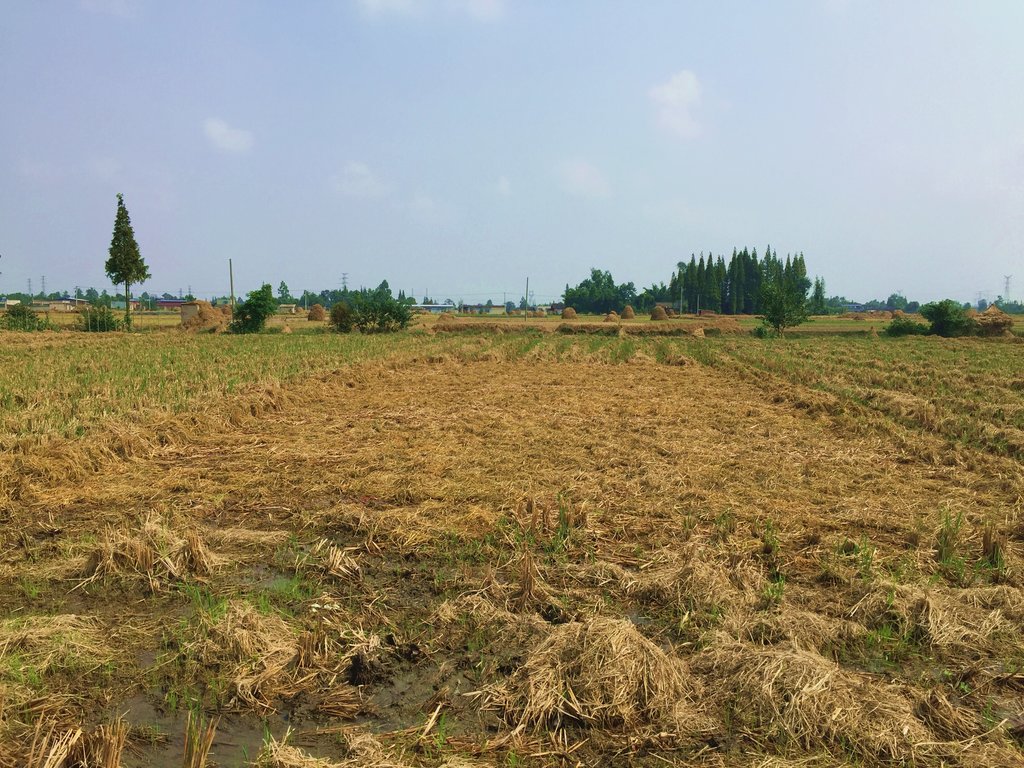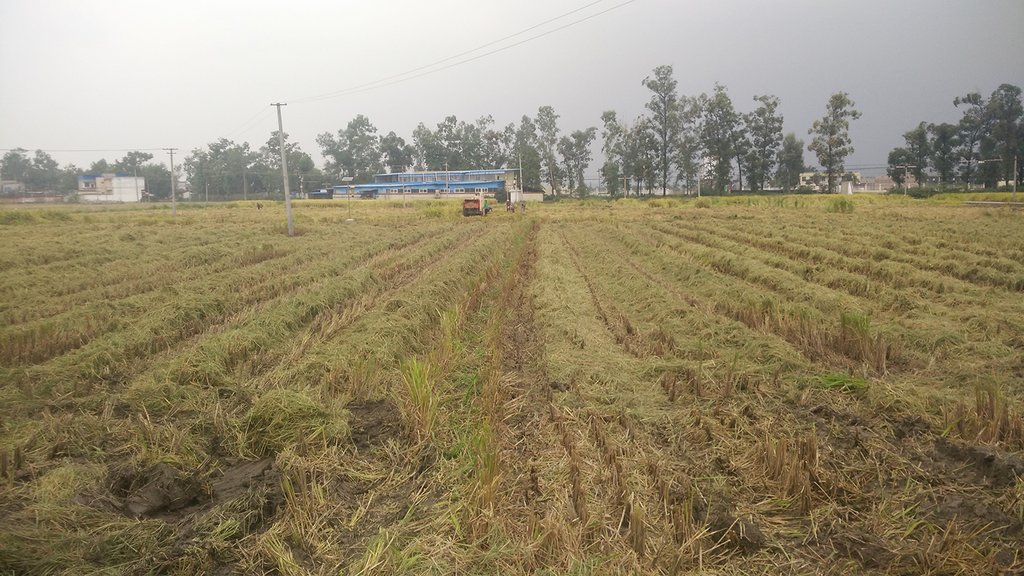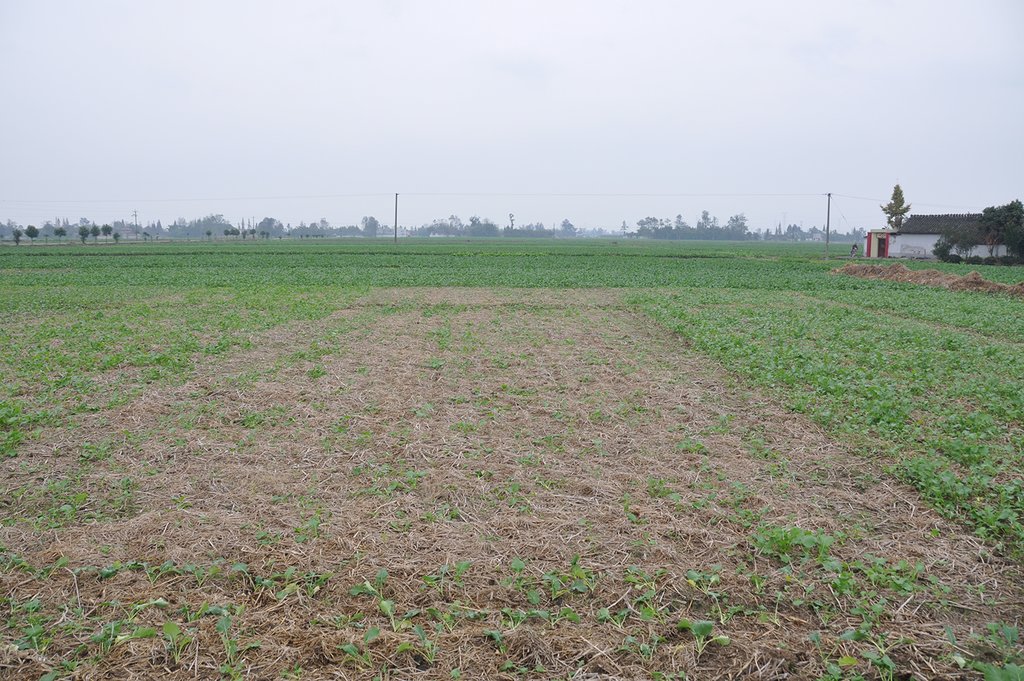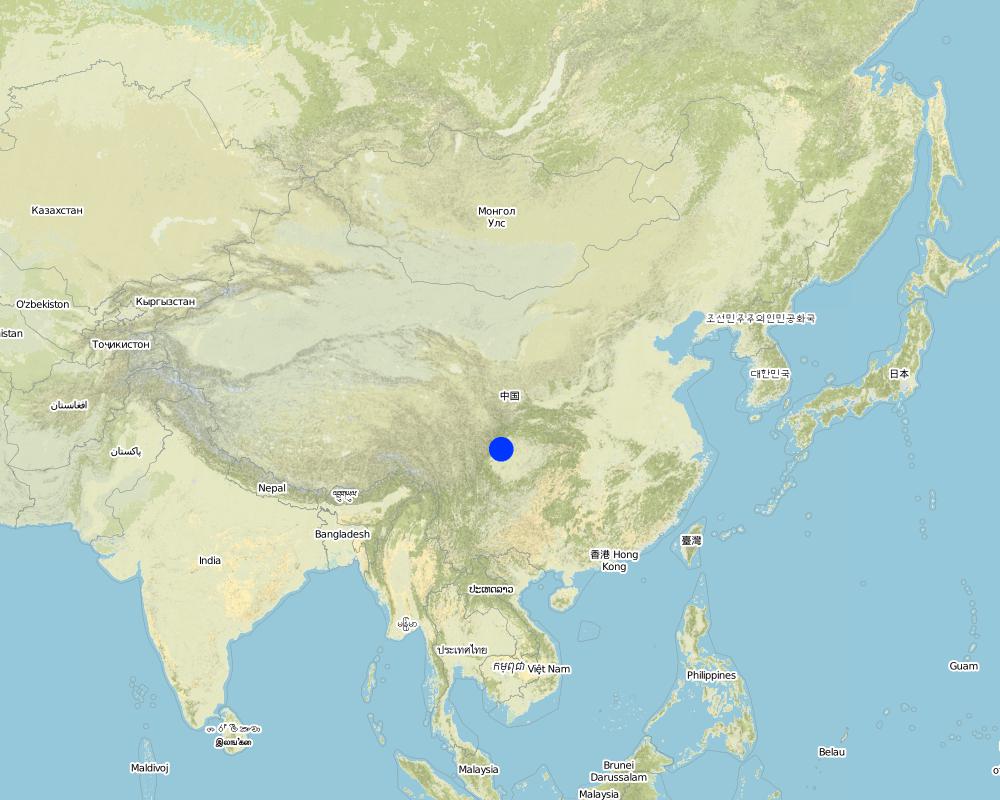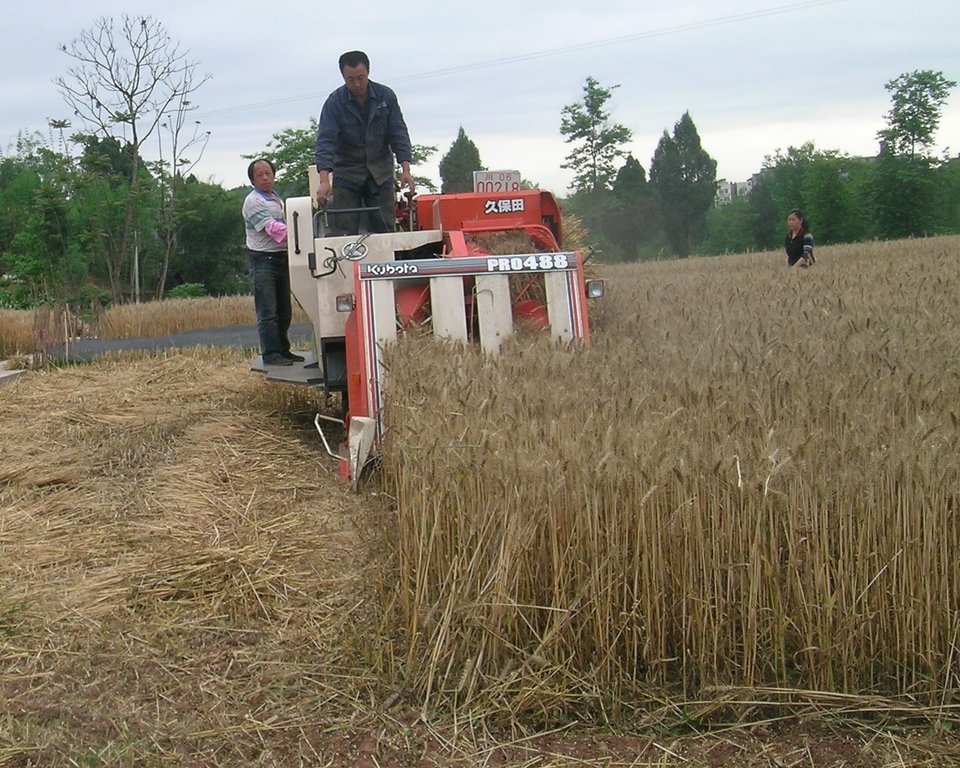Straw residues left on field after harvest and no tillage [ប្រទេសចិន]
- ការបង្កើត៖
- បច្ចុប្បន្នភាព
- អ្នកចងក្រង៖ Song Guo
- អ្នកកែសម្រួល៖ –
- អ្នកត្រួតពិនិត្យច្រើនទៀត៖ Gudrun Schwilch, Ursula Gaemperli, Alexandra Gavilano
No tillage planting
technologies_3239 - ប្រទេសចិន
ពិនិត្យមើលគ្រប់ផ្នែក
ពង្រីកមើលទាំងអស់ បង្រួមទាំងអស់1. ព័ត៌មានទូទៅ
1.2 ព័ត៌មានលម្អិតពីបុគ្គលសំខាន់ៗ និងស្ថាប័នដែលចូលរួមក្នុងការវាយតម្លៃ និងចងក្រងឯកសារនៃបច្ចេកទេស
បុគ្គលសំខាន់ម្នាក់ (ច្រើននាក់)
អ្នកជំនាញឯកទេស SLM:
Hongzhu Fan
Soil and Fertilizer Institute of the Sichuan Academy of Agricultural Sciences
ប្រទេសចិន
អ្នកប្រើប្រាស់ដី:
Wu Shengde
ប្រទេសចិន
ឈ្មោះគម្រោងដែលបានចងក្រងឯកសារ/ វាយតម្លៃលើបច្ចេកទេស (បើទាក់ទង)
Interactive Soil Quality assessment in Europe and China for Agricultural productivity and Environmental Resilience (EU-iSQAPER)ឈ្មោះអង្គភាពមួយ (ច្រើន) ដែលបានចងក្រងឯកសារ/ វាយតម្លៃបច្ចេកទេស (បើទាក់ទង)
‒ Soil and Fertilizer Institute of the Sichuan Academy of Agricultural Sciences (SFI) - ប្រទេសចិន1.3 លក្ខខណ្ឌទាក់ទងទៅនឹងការប្រើប្រាស់ទិន្នន័យដែលបានចងក្រងតាមរយៈ វ៉ូខេត
អ្នកចងក្រង និង(បុគ្គលសំខាន់ៗ)យល់ព្រមទទួលយកនូវលក្ខខណ្ឌនានាទាក់ទងទៅនឹងការប្រើប្រាស់ទិន្នន័យដែលបានចងក្រងតាមរយៈវ៉ូខេត:
បាទ/ចា៎
1.4 សេចក្តីប្រកាសស្តីពីចីរភាពនៃការពណ៌នាពីបច្ចេកទេស
តើបច្ចេកទេសដែលបានពណ៌នានេះមានបញ្ហាដែលផ្តោតលើការធ្លាក់ចុះគុណភាពដី, បើដូច្នេះវាមិនអាចត្រូវបានប្រកាសថាជាបច្ចេកទេសនៃការគ្រប់គ្រងប្រកបដោយចីរភាពទេ?
ទេ
2. ការពណ៌នាពីបច្ចេកទេស SLM
2.1 ការពណ៌នាដោយសង្ខេបពីបច្ចេកទេស
និយមន័យបច្ចេកទេស:
Method of this agricultual technology the rice straw will be left on the field after mechanized harvesting. Succession crop, such as rape, wheat or potato, were seeded directly under no tillage condition. Both measures aim at better soil regeneration and soil conditions for agriculture and subsequently increased yield and less soil degradation.
2.2 ការពណ៌នាលម្អិតពីបច្ចេកទេស
ការពណ៌នា:
The SLM practice (straw mulching and no tillage) is applied in the Chengdu Plain Paddy Soil. The Chengdu plain has mild climate and abundant rainfall. It belongs to the warm humid subtropical Pacific monsoon climate zone.The main types of soil in the Chengdu plain are paddy soil and purple soil.The total land resources of the Chengdu plain are 1331800 hectares, and the per capita land resources are about 0.1044 hectares per person. In 2010, the total amount of cultivated land in the Chengdu plain was 478069 hectares, accounting for 35.90% of the area of the plain, accounting for 42.36% of the total area of agricultural land in the region, and the per capita arable land area was only about 0.0375 hectares. The Chengdu Plain is an important grain production base in Sichuan. Rice field-upland field rotation (rice - wheat, rice - rapeseed) is an important agricultural system.
On the case study area, the N, P and K fertilizers were applied as urea, calcium superphosphate and potassium chloride at the rates of 120-150 kg N ha-1, 75-120 kg P2O5 ha-1,and 75-120 kg K2O ha-1, during every crop. During crop season, the rate of 60% of N, 100% of P, and 50% of K fertilizers were applied as base fertilizer, while remaining 40% of N and 50% of K were used as top dressing fertilizer. The main measures of this SLM is rice straw or wheat straw mulching while havesting (leaving the straw after havest scattered on the field). Crops were harvested by a combine harvester (Kuotian combine harvester, model PR0488), then straw and stubble of crops were left at size of less than 20 cm in the field. The seeding of succession crop such as wheat and oil seed rape is done by a direct seeding machine. The land users are working eighter with a contractor or they use their own machines and labour force. The purposes of this technology were to increase production and improve soil fertility. Although plough layer can become shallow by long-term no tillage cultivation, more and more land users like this technology because it promises increased grain yield, reduction of fertilizers (and subsequently cost), and it improves soil physical, chemical and biological properties of soil. Thus, it is expected that the measures of this SLM-Technology ends up in improved soil moisture, higher diversity of soil life and finally soil fertility .
2.3 រូបភាពនៃបច្ចេកទេស
2.5 ប្រទេស/តំបន់/ទីតាំងកន្លែង ដែលបច្ចេកទេសត្រូវបានអនុវត្ត និងបានគ្រប់ដណ្តប់ដោយការវាយតម្លៃនេះ
ប្រទេស:
ប្រទេសចិន
តំបន់/រដ្ឋ/ខេត្ត:
Basin plain, Chengdu, Sichuan
បញ្ជាក់បន្ថែមពីលក្ខណៈនៃទីតាំង:
Guanhan City, Wenjiang District, Chongzhou City
បញ្ជាក់ពីការសាយភាយនៃបច្ចេកទេស:
- ត្រូវបានផ្សព្វផ្សាយត្រឹមតំបន់មួយ
ប្រសិនបើមិនច្បាស់ពីទំហំផ្ទៃដី សូមធ្វើការប៉ាន់ប្រម៉ាណ:
- 100-1,000 គម2
មតិយោបល់:
This long-term straw mulch experiment was started in the 2005. This site is situated in subtropical monsoon region with anverage annual temperature of about 16.3℃, 281 days frost free. Annual precipitation is about 890mm.
Map
×2.6 កាលបរិច្ឆេទនៃការអនុវត្ត
ប្រសិនបើមិនច្បាស់ឆ្នាំ សូមបញ្ជាក់កាលបរិច្ឆេទដែលប្រហាក់ប្រហែល:
- 10-50 ឆ្នាំ
2.7 ការណែនាំពីបច្ចេកទេស
សូមបញ្ជាក់តើបច្ចេកទេសត្រូវបានណែនាំឱ្យអនុវត្តដោយរបៀបណា:
- ពេលកំពុងពិសោធន៍
មតិយោបល់ (ប្រភេទនៃគម្រោង ។ល។):
The current case study bases only on a test area within the scope of the iSQAPER Project. A long-term straw mulch and fertilization experiment was initiated in 2005 at Sichuan Academy of Agricultural Sciences Soil and Fertilizer Research Institute’s Guanghan agricultural experiment station in Sichuan province, southwest China. Thus, effects of long-term fertilization and straw much on crop yields, soil physical and chemical properties under rice-rapeseed rotation were assessed in a paddy soil
3. ចំណាត់ថ្នាក់នៃបច្ចេកទេស SLM
3.1 គោលបំណងចម្បង (១ ឬច្រើន) នៃបច្ចេកទេសនេះ
- ធ្វើឱ្យប្រសើរឡើងនូវផលិតកម្ម
- កាត់បន្ថយ, បង្ការ, ស្តារឡើងវិញនូវការធ្លាក់ចុះគុណភាពដី
- អភិរក្សប្រព័ន្ធអេកូឡូស៊ី
- អភិរក្ស/ធ្វើឱ្យប្រសើរឡើងជីវចម្រុះ
3.2 ប្រភេទដីប្រើប្រាស់មួយប្រភេទ (ច្រើនប្រភេទ) ដែលបានអនុវត្តបច្ចេកទេស

ដីដាំដំណាំ
- ដំណាំប្រចាំឆ្នាំ
ដំណាំប្រចាំឆ្នាំ - បញ្ជាក់ប្រភេទដំណាំ:
- ដំណាំដែលមានគ្រាប់ចម្រាញ់ប្រេងបាន - ផ្កាឈូករ័ត្ន ផ្កា rapeseed ផ្សេងៗ
- wheat, rice
ចំនួនសារដែលដាំដំណាំក្នុងមួយឆ្នាំ:
- 2
តើជាការអនុវត្តន៍ដំណាំវិលជុំ?
បាទ/ចា៎
បើបាទ/ច៎ា សូមបញ្ជាក់:
Method of this agricultual technology the rice straw will be left on the field after mechanized harvesting. Succession crop, such as rape, wheat or potato, were seeded directly under no tillage condition.
3.4 ការផ្គត់ផ្គង់ទឹក
ការផ្គត់ផ្គង់ទឹកនៅកន្លែងអនុវត្តបច្ចេកទេស:
- ទឹកភ្លៀង និងប្រព័ន្ធស្រោចស្រព
3.5 ក្រុម SLM ដែលបច្ចេកទេសស្ថិតនៅក្នុង
- ប្រព័ន្ធដំណាំបង្វិល (ការដាំដំណាំវិលជុំ ការទុកដីចោលដើម្បីបង្កើនជីជាតិ កសិកម្មពនេចរ)
- ធ្វើឱ្យប្រសើរឡើងគម្របដី/ ដំណាំគម្របដី
- កាត់បន្ថយការរំខានដល់ដី
3.6 វិធានការ SLM ដែលបញ្ចូលនូវបច្ចេកទេស

វិធានការក្សេត្រសាស្ត្រ
- A1: ដំណាំ/គម្របដី
- A2: សារធាតុសរីរាង្គ/ជីជាតិដី
- A3: ការរក្សាស្រទាប់ដីខាងលើ
3.7 កំណត់ប្រភេទនៃការធ្លាក់ចុះគុណភាពដីសំខាន់ៗដែលបច្ចេកទេសនេះបានដោះស្រាយ

ការធ្លាក់ចុះសារធាតុគីមីក្នុងដី
- Cn: ការថយចុះជីជាតិ និងកាត់បន្ថយបរិមាណសារធាតុសរីរាង្គ (មិនកើតឡើងដោយការហូរច្រោះទេ)

ការបាត់បង់រូបសាស្ត្រនៃដី
- Pc: ការហាប់ណែន
- Pk: ការបិទរន្ធដី
3.8 ការពារ កាត់បន្ថយ ឬស្តារឡើងវិញនៃការធ្លាក់ចុះគុណភាពដី
បញ្ជាក់ពីគោលដៅរបស់បច្ចេកទេស ដែលផ្តោតទៅការធ្លាក់ចុះគុណភាពដី:
- ការការពារការធ្លាក់ចុះគុណភាពដី
4. បច្ចេកទេសជាក់លាក់ សកម្មភាពអនុវត្ត ធាតុចូល និងថ្លៃដើម
4.1 គំនូសបច្ចេកទេសនៃបច្ចេកទេសនេះ
លក្ខណៈពិសេសនៃបច្ចេកទេស (ទាក់ទងនឺងគំនូរបច្ចេកទេស):
The SLM practice (straw mulching while harvesting and no tillage) is applied in the Chengdu Plain paddy soil. The main measures of this SLM method is straw mulching while harvesting and no tillage. Crops are harvested by machine (actually in this case study by Kuotian combine harvester/model was PR0488), and then straw and stubble were left at size of less than 20 cm on the soil surface. The N, P and K fertilizers to the succession crop were applied in form of urea, calcium superphosphate and potassium chloride at the rates of 120-150 kg N ha-1, 75-120 kg P2O5 ha-1, and 75-120 kg K2O ha-1. Rates of 60% of N, 100% of P and 50% of K fertilizers were applied as base fertilizers, while the remaining 40% of N and 50% of K were used as top dressing fertilizers. After previous crop harvest of rice the succession crop as for example wheat, oil rape, maize will be seeded directly under no tillage condition.
ឈ្មោះអ្នកនិពន្ធ:
Hongzhu Fan
កាលបរិច្ឆេទ:
30/10/2017
4.2 ព័ត៌មានទូទៅដែលពាក់ព័ន្ធនឹងការគណនាធាតុចូល និងថ្លៃដើម
កំណត់របៀបនៃការគណនាថ្លៃដើម និងធាតុចូល:
- ក្នុងតំបន់អនុវត្តបច្ចេកទេស
កំណត់ទំហំ និងឯកត្តាផ្ទៃដី:
1 hectare
ផ្សេងៗ/ រូបិយប័ណ្ណជាតិ (បញ្ជាក់):
Renminbi (RMB)
បើពាក់ព័ន្ធសូមកំណត់អត្រាប្តូរប្រាក់ពីដុល្លាទៅរូបិយប័ណ្ណតំបន់ (ឧ. 1 ដុល្លារ = 79.9 រៀលនៃរូបិយប័ណ្ណប្រេស៊ីល) ៖ 1 ដុល្លារ =:
6,6
កំណត់ថ្លៃឈ្នួលជាមធ្យមនៃការជួលកម្លាំងពលកម្មក្នុងមួយថ្ងៃ:
120 RMB per day
4.5 សកម្មភាពថែទាំ
| សកម្មភាព | ពេលវេលា/ ភាពញឹកញាប់ | |
|---|---|---|
| 1. | mechanized harvesting | August or September |
| 2. | spreading the straw residues after havest on the field | after harvest of crops |
| 3. | fertilization | October |
| 4. | no tillage and direct seeding | October |
4.6 កំណត់ថ្លៃដើមសម្រាប់ការថែទាំ/ សកម្មភាពរបស់បច្ចេកទេស (ក្នុងរយៈពេលមួយឆ្នាំ)
| បញ្ជាក់ពីធាតុចូល | ឯកតា | បរិមាណ | ថ្លៃដើមក្នុងមួយឯកតា | ថ្លៃធាតុចូលសរុប | % នៃថ្លៃដើមដែលចំណាយដោយអ្នកប្រើប្រាស់ដី | |
|---|---|---|---|---|---|---|
| កម្លាំងពលកម្ម | All reccurent labour (above) is done within the familiy* | person-day | 0,5 | 120,0 | 60,0 | 100,0 |
| សម្ភារៈ | harvester (machine from contractor without labour force)* | ha | 1,0 | 3000,0 | 3000,0 | 100,0 |
| សម្ភារៈ | Direct seeding machine (from contractor without labour force)* | ha | 1,0 | 1800,0 | 1800,0 | |
| សម្ភារៈដាំដុះ | seed (weat, rape) | kg | 120,0 | 2,0 | 240,0 | 100,0 |
| ជី និងសារធាតុពុល | urea | kg | 280,0 | 3,0 | 840,0 | 100,0 |
| ជី និងសារធាតុពុល | calcuim superphosphate | kg | 810,0 | 1,0 | 810,0 | 100,0 |
| ជី និងសារធាតុពុល | potassium chloride | kg | 200,0 | 3,5 | 700,0 | 100,0 |
| ថ្លៃដើមសរុបសម្រាប់ការថែទាំដំណាំតាមបច្ចេកទេស | 7450,0 | |||||
| ថ្លៃដើមសរុបសម្រាប់ការថែទាំដំណាំតាមបច្ចេកទេសគិតជាដុល្លារ | 1128,79 | |||||
មតិយោបល់:
*The labour (for harvesting, fertilizering and seeding ) is unpaid when those were done by farm familiy.
But in China, there is no contractor to do all work (for harvesting, fertilizing and seeding). If all works done by a contractor, farms will give up planting crops. Usually, a contractor provide machine to farm, but no labor. Farm members engaged in agricultural production will do most of the work by themselves in order to save cost.
4.7 កត្តាសំខាន់បំផុតដែលមានឥទ្ធិពលដល់ការចំណាយ
ពណ៌នាពីកត្តាប៉ះពាល់ចម្បងៗទៅលើថ្លៃដើម:
Most of important factor affecting the costs of this technology is the type of machine used for harvest. (E.g. cost is high by the mini combine harvester because of the low efficiency).
5. លក្ខណៈបរិស្ថានធម្មជាតិ និងមនុស្ស
5.1 អាកាសធាតុ
បរិមាណទឹកភ្លៀងប្រចាំឆ្នាំ
- < 250 មម
- 251-500 មម
- 501-750 មម
- 751-1,000 មម
- 1,001-1,500 មម
- 1,501-2,000 មម
- 2,001-3,000 មម
- 3,001-4,000 មម
- > 4,000 មម
តំបន់កសិអាកាសធាតុ
- មានភ្លៀងមធ្យម
5.2 សណ្ឋានដី
ជម្រាលជាមធ្យម:
- រាបស្មើ (0-2%)
- ជម្រាលតិចតួច (3-5%)
- មធ្យម (6-10%)
- ជម្រាលខ្ពស់បន្តិច (11-15%)
- ទីទួល (16-30%)
- ទីទួលចោត (31-60%)
- ទីទួលចោតខ្លាំង (>60%)
ទម្រង់ដី:
- ខ្ពង់រាប
- កំពូលភ្នំ
- ជម្រាលភ្នំ
- ជម្រាលទួល
- ជម្រាលជើងភ្នំ
- បាតជ្រលងភ្នំ
តំបន់តាមរយៈកម្ពស់ :
- 0-100 ម
- 101-500 ម
- 501-1,000 ម
- 1,001-1,500 ម
- 1,501-2,000 ម
- 2,001-2,500 ម
- 2,501-3,000 ម
- 3,001-4,000 ម
- > 4,000 ម
បញ្ជាក់ថាតើបច្ចេកទេសនេះត្រូវបានអនុវត្តន៍នៅក្នុង:
- មិនពាក់ព័ន្ធទាំងអស់
5.3 ដី
ជម្រៅដីជាមធ្យម:
- រាក់ខ្លាំង (0-20 សម)
- រាក់ (21-50 សម)
- មធ្យម (51-80 សម)
- ជ្រៅ (81-120 សម)
- ជ្រៅខ្លាំង (> 120 សម)
វាយនភាពដី (ស្រទាប់លើ):
- មធ្យម (ល្បាយ, ល្បាប់)
វាយនភាពដី (> 20 សម ស្រទាប់ក្នុង):
- គ្រើម/ មានពន្លឺ (ខ្សាច់)
សារធាតុសរីរាង្គនៅស្រទាប់ដីខាងលើ:
- មធ្យម (1-3%)
បើអាចសូមភ្ជាប់ការពណ៌នាពីដីឱ្យបានច្បាស់ ឬព័ត៌មានដែលអាចទទួលបាន ឧ. ប្រភេទដី, pH ដី/ ជាតិអាស៊ីត, សមត្ថភាពផ្លាស់ប្តូរកាចុង, វត្តមាននីត្រូសែន, ភាពប្រៃ ។ល។:
Soil type is alluvial soil, PH is 5.5, SOC 31.3g/kg, N 2.02g/kg,P 1.04g/kg, K 7.69g/kg, available nitrogen 189.7mg/kg, available phosphorus 12.6mg/kg, ammonium acetate extractable potassium95.5mg/kg.
5.4 ទឹកដែលអាចទាញមកប្រើប្រាស់បាន និងគុណភាពទឹក
នីវ៉ូទឹកក្រោមដី:
< 5 ម
ទឹកលើដីដែលអាចទាញយកប្រើប្រាស់បាន:
កម្រិតមធ្យម
គុណភាពទឹក (មិនបានធ្វើប្រត្តិកម្ម):
ទឹកពិសារដែលមានគុណភាពល្អ
តើមានបញ្ហាភាពទឹកប្រៃហូរចូលមកដែរឬទេ?
ទេ
តើទឹកជំនន់កំពុងកើតមាននៅតំបន់នេះដែររឺទេ?
ទេ
5.5 ជីវៈចម្រុះ
ភាពសម្បូរបែបនៃប្រភេទ:
- ខ្ពស់
ភាពសម្បូរបែបនៃទីជម្រក:
- ខ្ពស់
5.6 លក្ខណៈនៃអ្នកប្រើប្រាស់ដីដែលអនុវត្តបច្ចេកទេស
នៅមួយកន្លែង ឬពនេចរ :
- នៅមួយកន្លែង
ទីផ្សារនៃប្រព័ន្ធផលិតកម្ម:
- ពាក់កណ្តាលពាណិជ្ជកម្ម (ផ្គត់ផ្គង់ខ្លួនឯង/ ពាណិជ្ជកម្ម)
ចំណូលក្រៅកសិកម្ម:
- តិចជាង 10% នៃចំណូល
កម្រិតជីវភាព:
- មធ្យម
ឯកជន ឬក្រុម:
- ជាក្រុម/ សហគមន៍
កម្រិតប្រើប្រាស់គ្រឿងយន្ត:
- គ្រឿងយន្ត/ ម៉ាស៊ីន
យេនឌ័រ:
- ស្ត្រី
អាយុរបស់អ្នកប្រើប្រាស់ដី:
- វ័យកណ្តាល
5.7 ទំហំផ្ទៃដីជាមធ្យមនៃដីប្រើប្រាស់ដោយអ្នកប្រើប្រាស់ដី ក្នុងការអនុវត្តបច្ចេកទេស
- < 0.5 ហិកតា
- 0.5-1 ហិកតា
- 1-2 ហិកតា
- 2-5 ហិកតា
- 5-15 ហិកតា
- 15-50 ហិកតា
- 50-100 ហិកតា
- 100-500 ហិកតា
- 500-1,000 ហិកតា
- 1,000-10,000 ហិកតា
- > 10,000 ហិកតា
តើផ្ទៃដីនេះចាត់ទុកជាទំហំកម្រិតណាដែរ ខ្នាតតូច មធ្យម ឬខ្នាតធំ (ធៀបនឹងបរិបទតំបន់)?
- ខ្នាតមធ្យម
5.8 ភាពជាម្ចាស់ដី កម្មសិទ្ធប្រើប្រាស់ដី និងកម្មសិទ្ធប្រើប្រាស់ទឹក
ភាពជាម្ចាស់ដី:
- រដ្ឋ
កម្មសិទ្ធិប្រើប្រាស់ដី:
- ជាក្រុម (មានដែនកំណត់)
កម្មសិទ្ធប្រើប្រាស់ទឹក:
- ជាក្រុម (មានដែនកំណត់)
មតិយោបល់:
In China, land ownership belongs to the state, but land use rights belong to farm. In other words, farm can decide to plant rice, wheat, or fruit tree in the land, but the farm cannot sell this land.
5.9 ការប្រើប្រាស់សេវាកម្ម និងហេដ្ឋារចនាសម្ព័ន្ធ
សុខភាព:
- មិនល្អ
- មធ្យម
- ល្អ
ការអប់រំ:
- មិនល្អ
- មធ្យម
- ល្អ
ជំនួយបច្ចេកទេស:
- មិនល្អ
- មធ្យម
- ល្អ
ការងារ (ឧ. ការងារក្រៅកសិដ្ឋាន):
- មិនល្អ
- មធ្យម
- ល្អ
ទីផ្សារ:
- មិនល្អ
- មធ្យម
- ល្អ
ថាមពល:
- មិនល្អ
- មធ្យម
- ល្អ
ផ្លូវ និងការដឹកជញ្ជូន:
- មិនល្អ
- មធ្យម
- ល្អ
ទឹកផឹក និងអនាម័យ:
- មិនល្អ
- មធ្យម
- ល្អ
សេវាកម្មហិរញ្ញវត្ថុ:
- មិនល្អ
- មធ្យម
- ល្អ
6. ផលប៉ះពាល់ និងការសន្និដ្ឋាន
6.1 ផលប៉ះពាល់ក្នុងបរិវេណអនុវត្តបច្ចេកទេសដែលកើតមាន
ផលប៉ះពាល់លើសេដ្ឋកិច្ចសង្គម
ផលិតផល
ផលិតកម្មដំណាំ
គុណភាពមុន SLM:
14.9 t ha-1*
គុណភាពក្រោយ SLM:
15.5 t ha-1*
មតិយោបល់/ ការបញ្ជាក់:
* yield for rape
Wheat yield were 6.3 t ha-1 before SLM and 6.7 t ha-1 after SLM, respectively. Rice yield were 8.6 t ha-1 before SLM and 8.8 t ha-1 after SLM, respectively.
ការគ្រប់គ្រងដី
មតិយោបល់/ ការបញ្ជាក់:
No tillage is an important way to reduce cost by machine plough field. Less fertilizing work and amount of fertilizers by leaving straw on field (straw contains a large amount of C, N, P, and K)
ទឹកដែលអាចទាញមកប្រើប្រាស់បាន និងគុណភាពទឹក
តម្រូវការទឹកសម្រាប់ស្រោចស្រព
មតិយោបល់/ ការបញ្ជាក់:
Straw mulching can decreased demand for irrigation water, because water can be keep in the straw, and straw mulching on the soil also can reduced evaporation of water.
ចំណូល និងថ្លៃដើម
ការចំណាយលើធាតុចូលកសិកម្ម
មតិយោបល់/ ការបញ្ជាក់:
No tillage is an important way to reduce cost by machine plough field. Less fertilizing work and amount of fertilizers by straw return compared with no straw mulching (straw contains a large number of C, N, P and K. Therefore agricultural inputs can be reduced.
ចំណូលក្នុងកសិដ្ឋាន
មតិយោបល់/ ការបញ្ជាក់:
Do to better yield and reduction of costs.
បន្ទុកការងារ
ផលប៉ះពាល់ទៅលើវប្បធម៌សង្គម
ចំណេះដឹង SLM / ការធ្លាក់ចុះគុណភាពដី
មតិយោបល់/ ការបញ្ជាក់:
Increased knowledge on the benefits of straw mulching by the land users.
ផលប៉ះពាល់ទៅលើអេកូឡូស៊ី
ដី
សំណើមដី
មតិយោបល់/ ការបញ្ជាក់:
Due to straw mulching, because the water can be kept in the straw and soil evaporation can be reduced to improved oil cover.
គម្របដី
មតិយោបល់/ ការបញ្ជាក់:
Due to the mulching by straw, the soil remain covered practically the whole year round.
ដីប្រេះ
មតិយោបល់/ ការបញ្ជាក់:
Without ploughing the soil crusting can occur at long term use of the technology (findings from a long-term straw mulch and fertilization experiment was initiated in 2005 at Sichuan Academy of Agricultural Sciences Soil and Fertilizer Research Institute’s Guanghan agricultural experiment station in Sichuan province)
ដីហាប់
មតិយោបល់/ ការបញ្ជាក់:
Without ploughing the soil gets more compact at long term use of the technology (findings from a long-term straw mulch and fertilization experiment was initiated in 2005 at Sichuan Academy of Agricultural Sciences Soil and Fertilizer Research Institute’s Guanghan agricultural experiment station in Sichuan province)
វដ្តនៃសារធាតុចិញ្ចឹម/ការទទួលបាន
សារធាតុសរីរាង្គដី/ការបូនក្រោមដី
មតិយោបល់/ ការបញ្ជាក់:
Due to mulching by rice straw (crop residues)
ជីវចម្រុះ៖ ដំណាំ, សត្វ
ជីវម៉ាស/ កាបូនលើដី
មតិយោបល់/ ការបញ្ជាក់:
Due to mulching by rice straw (crop residues)
ភាពសម្បូរបែបនៃសត្វ
មតិយោបល់/ ការបញ្ជាក់:
Due to mulching by rice straw (crop residues), soil life has increased.
ប្រភេទសត្វមានប្រយោជន៍
ការកាត់បន្ថយហានិភ័យនៃគ្រោះមហន្តរាយ និងគ្រោះអាកាសធាតុ
ការបំភាយនៃកាបូន និងឧស្ម័នផ្ទះកញ្ចក់
មតិយោបល់/ ការបញ្ជាក់:
Traditional burning of rice straw on the fields has been reduced, as straw is needed for mulching. Subsequently the C can be bound within the soil and will not be emitted into the air in form of CO2.
6.2 ផលប៉ះពាល់ក្រៅបរិវេណអនុវត្តបច្ចេកទេសដែលកើតមាន
ផលប៉ះពាល់នៃឧស្ម័នផ្ទះកញ្ចក់
មតិយោបល់/ ការបញ្ជាក់:
Traditional burning of rice straw on the fields has been reduced, as straw is needed for mulching. Subsequently the C can be bound within the soil and will not be emitted into the air in form of CO2.
6.4 ការវិភាគថ្លៃដើម និងអត្ថប្រយោជន៍
តើផលចំណេញ និងការថែទាំ/ ជួសជុលត្រូវបានប្រៀបធៀបគ្នាយ៉ាងដូចម្តេច (ទស្សនៈរបស់អ្នកប្រើប្រាស់ដី)?
រយៈពេលខ្លី:
វិជ្ជមានតិចតួច
រយៈពេលវែង:
វិជ្ជមាន
6.5 ការទទួលយកបច្ចេកទេស
- 11-50%
ក្នុងចំណោមគ្រួសារទាំងអស់ដែលបានអនុវត្តបច្ចេកទេស តើមានប៉ុន្មានគ្រួសារដែលចង់ធ្វើដោយខ្លួនឯង ដោយមិនទទួលបានសម្ភារៈលើកទឹកចិត្ត/ប្រាក់ឧបត្ថម្ភ?:
- 91-100%
6.6 ការបន្សុំា
តើថ្មីៗនេះ បច្ចេកទេសនេះត្រូវបានកែតម្រូវដើម្បីបន្ស៊ាំទៅនឹងស្ថានភាពប្រែប្រួលដែរឬទេ?
ទេ
6.7 ភាពខ្លាំង/ គុណសម្បត្តិ/ ឱកាសនៃបច្ចេកទេស
| ភាពខ្លាំង/ គុណសម្បត្តិ/ ឱកាសនៅកន្លែងរបស់អ្នកប្រើប្រាស់ដី |
|---|
| This technology can improve the yield |
| It can save labour by leaving straw on the field |
| ភាពខ្លាំង/ គុណសម្បត្តិ/ ឱកាស ទស្សនៈរបស់បុគ្គលសំខាន់ៗ |
|---|
| Straw mulching can increase the soil carbon input, and improve the soil quantity. |
| This technology can reduce land degradation. |
6.8 ភាពខ្សោយ/ គុណវិបត្តិ/ ហានិភ័យនៃបច្ចេកទេស និងវិធីសាស្ត្រដោះស្រាយ
| ភាពខ្សោយ/ គុណវិបត្តិ/ ហានិភ័យ ទស្សនៈរបស់អ្នកប្រើប្រាស់ដី | តើបច្ចេកទេសទាំងនោះបានដោះស្រាយបញ្ហាដូចម្តេច? |
|---|---|
| Soil structure was deteriorated by no tillage cultivation. | tillage |
| ភាពខ្សោយ/ គុណវិបត្តិ/ ហានិភ័យ ទស្សនៈរបស់អ្នកចងក្រងឬបុគ្គលសំខាន់ៗ | តើបច្ចេកទេសទាំងនោះបានដោះស្រាយបញ្ហាដូចម្តេច? |
|---|---|
| Soil hardening occured, and also a thin impervious layer was built at the soil surface | It could be good to plough up the soil after an interval of 5 years |
| Obstruction of rainwater infiltration | |
| Soil plough layer becomes shallow |
7. ឯកសារយោង និងវេបសាយ
7.1 វិធីសាស្ត្រ/ ប្រភពនៃព័ត៌មាន
- ការសម្ភាសន៍ជាមួយអ្នកប្រើប្រាស់ដី
94 people
- ការចងក្រងពីរបាកការណ៍ និងឯកសារផ្សេងៗទៀតដែលមាន
តើពេលណាដែលទិន្នន័យបានចងក្រង (នៅទីវាល)?
20/09/2016
7.2 ឯកសារយោងដែលបានចេញផ្សាយ
ចំណងជើង អ្នកនិពន្ធ ឆ្នាំ ISBN:
Composition of Wheat Rhizosphere Antagonistic Bacteria and Wheat Sharp Eyespot as Affected by Rice Straw Mulching. CHEN Huai-Gu, CAO Qi-Guang, XIONG Gui-Lin, LI Wei, ZHANG Ai-Xiang, YU Han-Shou and WANG Jin-Sheng.2010.
មានប្រភពមកពីណា? ថ្លៃដើមប៉ុន្មាន?
ScienceDirect. No
ចំណងជើង អ្នកនិពន្ធ ឆ្នាំ ISBN:
Effects of pre-sowing irrigation and straw mulching on the grain yieldand water use efficiency of summer maize in the North China Plain. Zhenxing Yan, Chao Gao, Yujie Ren, Rui Zong, Yuzhao Ma, Quanqi Li. 2017
មានប្រភពមកពីណា? ថ្លៃដើមប៉ុន្មាន?
ScienceDirect. No
ចំណងជើង អ្នកនិពន្ធ ឆ្នាំ ISBN:
Effects of snow cover plus straw mulching on microorganisms in paddy soil during winter.Hao Zhanga,b, Jie Tanga, Shuang Liang.2017
មានប្រភពមកពីណា? ថ្លៃដើមប៉ុន្មាន?
ScienceDirect. No
ចំណងជើង អ្នកនិពន្ធ ឆ្នាំ ISBN:
Effects of Non-flooded Cultivation with Straw Mulching on Rice Agronomic Traits and Water Use Efficiency. QIN Jiang-tao , HU Feng , LI Hui-xin , WANG Yi-ping , HUANG Fa-quan , HUANG Hua-xiang.2006
មានប្រភពមកពីណា? ថ្លៃដើមប៉ុន្មាន?
ScienceDirect. No
ចំណងជើង អ្នកនិពន្ធ ឆ្នាំ ISBN:
Growth Characteristics and Yield of Late-Season Rice under No-tillageand Non-flooded Cultivation with Straw Mulching. WANG Dong, LI Hui-xin, QIN Jiang-tao, LI Da-ming, HU Feng.2010
មានប្រភពមកពីណា? ថ្លៃដើមប៉ុន្មាន?
ScienceDirect. No
ចំណងជើង អ្នកនិពន្ធ ឆ្នាំ ISBN:
Impact of tillage practices on soil bacterial diversity and composition under the tobacco-rice rotation in China. Yanping Lei, Yongliang Xiao, Lifeng Li,Chaoqiang Jiang, Chaolong Zu, Tian Li, and Hui Cao.2017
មានប្រភពមកពីណា? ថ្លៃដើមប៉ុន្មាន?
ScienceDirect. No
ចំណងជើង អ្នកនិពន្ធ ឆ្នាំ ISBN:
Nutrient Decomposition Rate and Sugarcane Yield as Influenced by Mung Bean Intercropping and Crop Residue Recycling Tie-Guang He,Li-Rong Su,Yang-Rui Li,Tian-Ming Su2 Fang Qin,Qin Li.2017
មានប្រភពមកពីណា? ថ្លៃដើមប៉ុន្មាន?
ScienceDirect. No
ចំណងជើង អ្នកនិពន្ធ ឆ្នាំ ISBN:
Process rates of nitrogen cycle in uppermost topsoil after harvesting in no-tilled and ploughed agricultural clay soil. Merjo Laine . Tobias Ru¨ tting . Laura Alakukku . Ansa Paloja¨rvi . Rauni Stro¨mmer.2017
មានប្រភពមកពីណា? ថ្លៃដើមប៉ុន្មាន?
ScienceDirect. No
ចំណងជើង អ្នកនិពន្ធ ឆ្នាំ ISBN:
Research on the effect of straw mulching on the soil moisture by field experiment in the piedmont plain of the Taihang Mountains. LI Man, ZHANG Wei, HE Yu-jiang, WANG Gui-ling.2017
មានប្រភពមកពីណា? ថ្លៃដើមប៉ុន្មាន?
ScienceDirect. No
ចំណងជើង អ្នកនិពន្ធ ឆ្នាំ ISBN:
Rice–wheat cropping system: tillage, mulch, and nitrogen effects on soil carbon sequestration and crop productivity Keshav R. Adhikari,Khem R. Dahal,Zueng-Sang Chen,Yih-Chi Tan,Jihn-Sung Lai.2017
មានប្រភពមកពីណា? ថ្លៃដើមប៉ុន្មាន?
ScienceDirect. No
ចំណងជើង អ្នកនិពន្ធ ឆ្នាំ ISBN:
Soil Carbon Sequestration and Crop Yields in Rice–Wheat and Sugarcane–Ratoon–Wheat Cropping Systems Through Crop Residue Management and Inoculation of Trichoderma viride in Subtropical India.S. K. Shukla,Swaha Shee,S. K. Maity,S. Solomon,S. K. Awasthi,Asha Gaur,A. D. Pathak,V. P. Jaiswal.2017
មានប្រភពមកពីណា? ថ្លៃដើមប៉ុន្មាន?
ScienceDirect. No
ចំណងជើង អ្នកនិពន្ធ ឆ្នាំ ISBN:
成都平原麦稻双免耕秸秆还田技术模式.汤永禄 , 黄钢, 郑家国, 李朝苏,邓先和,付书明.2008
មានប្រភពមកពីណា? ថ្លៃដើមប៉ុន្មាន?
http://www.cnki.net/. No
ចំណងជើង អ្នកនិពន្ធ ឆ្នាំ ISBN:
Influence of straw mulching with no-till on soil nutrients and carbon pool management index.CHEN Shang-hong, ZHU Zhong-lin, LIU Ding-hui, SHU Li , WANG Chang-quan.2008
មានប្រភពមកពីណា? ថ្លៃដើមប៉ុន្មាន?
http://www.cnki.net/. No
7.3 ការភ្ជាប់ទៅកាន់ព័ត៌មានពាក់ព័ន្ធលើប្រព័ន្ធអនឡាញ
ចំណងជើង/ ពណ៌នា:
Effects of pre-sowing irrigation and straw mulching on the grain yieldand water use efficiency of summer maize in the North China Plain.
វេបសាយ:
http://dx.doi.org/10.1016/j.agwat.2017.02.017
ចំណងជើង/ ពណ៌នា:
Effects of snow cover plus straw mulching on microorganisms in paddy soil during winter
វេបសាយ:
http://dx.doi.org/10.1016/j.apsoil.2017.05.023
ចំណងជើង/ ពណ៌នា:
Growth Characteristics and Yield of Late-Season Rice under No-tillageand Non-flooded Cultivation with Straw Mulching
វេបសាយ:
DOI: 10.1016/S1672-6308(08)60117-1
ចំណងជើង/ ពណ៌នា:
Impact of tillage practices on soil bacterial diversity and composition under the tobacco-rice rotation in China
វេបសាយ:
DOI 10.1007/s12275-017-6242-9
ចំណងជើង/ ពណ៌នា:
Nutrient Decomposition Rate and Sugarcane Yield as Influenced by Mung Bean Intercropping and Crop Residue Recycling
វេបសាយ:
DOI 10.1007/s12355-017-0548-0
ចំណងជើង/ ពណ៌នា:
Process rates of nitrogen cycle in uppermost topsoil after harvesting in no-tilled and ploughed agricultural clay soil
វេបសាយ:
DOI 10.1007/s10705-017-9825-2
ចំណងជើង/ ពណ៌នា:
Rice–wheat cropping system: tillage, mulch, and nitrogen effects on soil carbon sequestration and crop productivity
វេបសាយ:
DOI 10.1007/s10333-015-0511-1
ចំណងជើង/ ពណ៌នា:
Soil Carbon Sequestration and Crop Yields in Rice–Wheat and Sugarcane–Ratoon–Wheat Cropping Systems Through Crop Residue Management and Inoculation of Trichoderma viride in Subtropical
វេបសាយ:
DOI 10.1007/s12355-016-0470-x
ការតភ្ជាប់ និងម៉ូឌុល
ពង្រីកមើលទាំងអស់ បង្រួមទាំងអស់ការតភ្ជាប់
គ្មានការតភ្ជាប់
ម៉ូឌុល
គ្មានម៉ូឌុល


